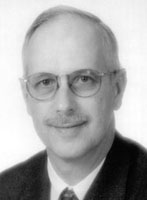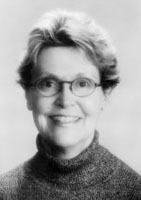 |
||
 |
 |
 |
Bruce Grotenhuis Howell |
Karen Langs Petoskey |
Bill McDaniel |
(click on Inductee's name to read 'description')
 |
||
 |
 |
 |
Bruce Grotenhuis Howell |
Karen Langs Petoskey |
Bill McDaniel |
(click on Inductee's name to read 'description')

But
when Hoke became ill in the early ‘90s, Bruce Grotenhuis, who had learned this
stuff from scratch in the process of teaching a class in computer fundamentals,
took over. The result has been a website that is nothing short of a bragging right,
one which offers an enormous assortment of information. From pictures of the all-state
players to pictures of those who have been inducted into the Hall of Fame, from
information about who is in your regional (the most often-asked question, some
say) to information about who won coach of the year honors, answers are only a
click away, thanks to the hours of work that Bruce has contributed. Given the
excellence of his work, it is not surprising that he is the webmaster for five
organizations.
Bruce’s
efforts in this area are merely indicative of the way he has contributed to our
organization for the past two decades. At about the same time he assumed Hoke’s
website duties, he took over the Tournament Clearinghouse from Tim Coleman. This
is a database through which coaches can search for opportunities to participate
in the all-important Saturday tournaments (and, of course, it can be found on
the website). In 1999, he also assumed duties in public relations, a natural transition
in that he was already publishing information regarding Hall of Fame inductees,
all state players, and coaches of the year anyway. He served on the association’s
board as assistant director for District 2 from 1983-1999. He still occupies a
position on the board as an officer.
All
of this was done in classic quiet fashion. You might not have known that Bruce
was in the room but you knew he had been there because the job had been done,
and done well.
This
applies to his coaching duties, too. For over 15 years, Bruce has directed the
Kensington Valley Conference Tennis Meet, even though his teams have only won
the title twice. Six times over the past four years, he has volunteered to help
as assistant director at one of the state tennis final tournaments. He annually
hosts the Howell Memorial Tournament and a JV Tournament, and has managed two
girls regional events.
Even
though he is quiet and self-effacing, Bruce’s efforts have not gone unnoticed.
He has been the MHSTeCA’s Regional Coach of the Year three times and won state
honors as 2002 Boys Coach of the Year. He was inducted into the Howell High School
Hall of Fame in 2002.
In
other words, Bruce has been recognized for spending lots of effective time on
the courts of
A
high school doubles player from
For
Karen, starting from scratch first meant a gutsy move from
That’s
because the couple took their love of tennis with them, having “fallen into” the
game when Karen took a phys ed class at MSU. She had signed up for bowling class
but it was full; thus the school asked students to voluntarily sign up for something
else. She chose tennis, where she met Russ who became her doubles partner in more
ways than one.
In
the mid-70s, George Haggerty, an entrepreneur from Grosse Pointe, built a racquet
club in Petoskey where Karen continued to play. She entered USTA tournaments and
was club doubles champion several times.
But
as parents of future tennis players, she and Russ realized that their children
simply could not compete with kids in the Western Michigan District of the then
Western Tennis Association (now the
Therefore,
together with Carolyn Creager of Traverse City, Karen and her comrades “started
from scratch” by establishing the Northern Michigan Tennis Association, a separate
district. Karen was the organization’s first secretary. She and others attended
WTA meetings throughout the
About
that time,
As
it turned out, she loved the job, and 25 years later, she has been a linchpin
of not only community tennis in Petoskey but of high school tennis statewide.
Karen has represented
And
they win. Under Karen’s direction, Petoskey girls have beaten opponents 163 times
as against 57 losses. They have taken home their share of Saturday tournament
trophies, captured four regional titles and been in the Top Ten at the end of
the year several times. In doing so, they, in the words of Hall of Famer Chuck
Wright, who worked with and competed against her for several years while living
in
“She
is a terrific coach who teaches life skills as much as tennis,” said Wright. “Her
players learn to compete hard, handle winning and losing with poise and maturity,
and handle adverse competitive situations with calm and politeness.”
Echoed
Hall of Famer Harold Holcomb, “Karen has always conducted herself in a classy
way and so have her teams. She and her husband Russ are great positive examples
for the Petoskey players to emulate.”
Karen was given the Stanley Malless Award in recognition of her distinguished service in the development and organization of tennis in her area. She was our association’s Class B Coach of the Year in 1985. She adds one more plaque to an undoubtedly already crowded trophy room, this one signifying entrance into the tennis coaches Hall of Fame.
The
numbers are nothing short of astonishing. Under Bill McDaniel, Holly tennis players
have captured 34 Flint Metro League championships. The boys have won 13 and currently
have a 9-year string in progress. The girls have put together an astounding 21
consecutive titles. In addition, over Bill’s 32 years of coaching (starting in
1975 for boys and 1981 for girls) the Bronchos have taken home 8 regional trophies,
been to 25 state tournaments, and were victorious in dual meets 344 times.
But
it wasn’t always this way. It took Bill ten years of hard work before he celebrated
his first boys’ league title. In the fall of 1981, his first as girls coach, the
team was 10-5, 3rd in the league, and 9th in the regionals, The very
next year, the squad started 21 years of ongoing history.
But
there is more to the story than titles and trophies. Indeed, there is a section
in the MHSTeCA Hall of Fame application entitled “Beyond the Numbers” which asks
for information about an applicant that transcends wins and losses. It seeks to
establish that a coach did more than merely toss out balls and then perhaps sit
back in an easy chair to watch his kids win year after year.
Former
player Glen Koeske supports this criteria when he says: “What can’t be easily
measured is the benefit a coach has on a community or the positive effect on the
lives of the students and parents he or she is involved with.” Koeske goes on
to say, “Personally, I cannot imagine what my life would be like if I had not
had the pleasure of knowing Bill McDaniel.”
Legions
of Holly tennis players can say Amen to that statement. Over the years, Bill has
been an integral part of the lives of his “tennis kids,” a designation that remains
long after they have graduated into adulthood. Even when they are still in high
school, his contact with them doesn’t end with the seasons of competition. Former
players testify that he seems to be everywhere in the Holly community: at Little
League games cheering on his tennis kids, for instance. He can be found at the
hospital visiting a player who had suffered an automobile accident or, in the
case of another, who was battling leukemia.
Indeed,
Bill took his own turn in the hospital, having suffered two heart attacks in 1997.
Colleagues credit the experience with producing a kinder, gentler coach who was
able to more
The
new facility is state of the art, a complex of 12 courts that community members
and opponents alike rave about. Opened in 1999, it gives the Holly community 21
tennis courts at three school sites. What is notable is that the board of education
allowed Bill to do the design. What is also notable is that the initiative was
approved without hesitation or opposition.
Why?
A logical explanation is that a substantial number in the Holly community had
experienced first-hand the results of Bill’s extraordinary efforts. An expansive
and flourishing summer tennis program has brought out kids with racquets in hand
for eight weeks, six hours a day, five days a week. There are junior high programs
for girls in the fall and boys in the spring. And for over a generation, high
school players have taken tennis experiences with them after graduation, remembering
their ever-encouraging motivator.
Former
player Angie Fenton calls him “a life coach.” She goes on to say that Bill expected
his players to “work, run, try, stretch, strain, yearn, live, grow, and grow some
more.” Board president Ron Palmgren, whose three kids played for Bill, describes
him as “demanding and fair, critical and constructive, analytical and encouraging,
perceptive and instructive, understanding and patient.” Allstate player Kristen
Fettig, who initially locked horns with Bill over her perception of his constructive
criticism and “you can do it” attitude", ended up praising him for getting
under her skin. “Bill knew exactly what it took to drive me, motivate me and make
me want it that much more anger,” she once wrote. “It takes a leader to identify
an emotion that will help motivate someone.”
This
is a leader who, according to Hall of Famer Jim Fowler, routinely makes his kids
stay after the regional tournament is over to clean up the litter and debris from
two days of competition. This is a leader who has built and sustained a successful
tennis program for almost 30 years at the grass-roots level in a rural community
that has one of the lowest per student funding levels in